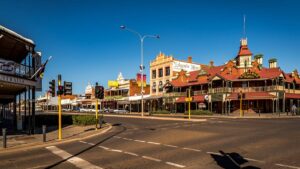Monsters of Rock: Lithium giants attempt to ride out the storm

It's getting pretty rough out hear for lithium producers. Pic: Getty Images
- Lithium prices continue to weigh on majors, with Albemarle planning to cut 6-7% of its global workforce
- Arcadium reports results, while Vulcan announces first lithium hydroxide product for qualification at German ‘zero carbon’ project
- Miners up as Chinese stimulus hopes rise and US Fed rate cut lifts goldies
Albemarle boss J. Kent Masters suggested lithium prices will continue to lag as the US lithium giant announced plans to chop 6-7% of its workforce as the part-owner of the Greenbushes mine tightens the belt further.
The world’s biggest lithium producer, which has its tentacles in every key battery supply chain outpost across the US, China, South America and Australia, was caught unawares, somehow, by the sudden decline in prices over the past year.
Now its tone has turned extremely bearish, as it posted a write-off fuelled US$1.1bn loss for the September quarter.
At average chemical pricing of US$12-15/kg for 2024, the New York listed company expects to generate US$900m to US$1.2bn in adjusted EBITDA for the year. Sales fell from US$2.3bn in Q3 2023 to US$1.4bn in Q3 2024.
Capex for 2025 will be cut by 50% to US$800-900m, with Albemarle already having suspended work to construct two additional 25,000tpa lithium hydroxide trains at a plant near Bunbury in WA’s South West.
“We do think the price is going to be lower for longer,” Masters said on Wednesday this week in an interview with Reuters. “We’re positioning the company to compete at that level.”
Other global lithium players were slightly more bullish in their results.
Notably, Arcadium Lithium (ASX:LTM) delivered average pricing of US$16,200/t on its lithium hydroxide and carbonate sales, outperforming the broader market due to contracts with long term customers.
Arcadium pulled in US$141.6m in Q3 revenue for 8750t of chemical sales, US$39.4m on 480 lithium carbonate equivalent tonnes of Butyllithium and other specialty non-battery products at prices of US$82,100/t LCE and US$22.1m for 32,400t of 5.3% Li2O spodumene concentrate from its marginal Mt Cattlin mine in WA at prices of US$682/t (US$770 SC6).
“We continued to deliver strong average realized pricing in a challenging market in the third quarter, supported by our commercial strategy in lithium hydroxide which focuses on long term strategic customers,” Arcadium boss Paul Graves said.
“Our nine-month year-to-date average realized pricing of $18,000/t for combined hydroxide and carbonate demonstrates our ability to achieve higher pricing than market indices in current market conditions.
“We remain focused on cost and operational discipline, executing cost saving initiatives and prudently advancing our expansion projects, prioritising Sal de Vida and Nemaska Lithium.”
Prices for chemical products were falling however, from US$17,200/t in the June quarter. Adjusted EBITDA was US$42.9m with net income of US$16.1m.
Could lithium volumes continue to grow?
Prices have fallen sharply in 2023 and 2024, with hopes growing with lithium carbonate at ~US$10,800/t and spodumene spot prices rebounding slightly in recent days to US$810/t that we could be at the bottom.
READ: Why pain can turn to gain for lithium prices
That’s certainly the hope of the industry’s big players, exemplified in the $10 billion takeover offer mining giant Rio Tinto (ASX:RIO) has lobbed for Arcadium.
It came not long after Pilbara Minerals (ASX:PLS) launched its counter-cyclical $560 million all scrip acquisition of Latin Resources (ASX:LRS), owner of the Salinas hard rock lithium project in Brazil.
In the short term, it’s decided to shutter its Ngungaju plant, with the aim of taking material out of an oversupplied market.
Whether that really moves the needle remains to be seen, with Fastmarkets battery metals analyst William Adams saying recently the industry will continue to see large surpluses in the next year.
“Pilbara Minerals’ production cut is a step in the right direction, but whereas the last time the Ngungaju plant was closed in October 2020, when it was operated by Altura Metals, it signalled the end of the bear market, this time its closure will not have the same effect,” he said.
“The cutback, an equivalent to around 12,500 tonnes LCE, on its own will not be enough to stop the oversupply – Fastmarkets’ forecasts is for a supply surplus of around 90,000 tonnes LCE next year, on top of this year’s 100,000+ tonnes surplus – so a lot more cuts are going to be needed.”
Few companies are looking to bring on new production at these prices, with Pilbara, Liontown Resources (ASX:LTR), Arcadium, Ganfeng and the Greenbushes JV all among the established or emerging players bringing large additional raw materials volumes into the market in the next couple years.
But Vulcan Energy Resources (ASX:VUL) has announced first production on Friday of lithium hydroxide from its geothermal brine project in Germany’s Rhine Valley, which it says will use no fossil fuels at all in its process.
The company has Stellantis, Renault, LG and Umicore on board as offtakers, with an optimisation plant currently operating while it constructs the 24,000tpa first phase plant dubbed Lionheart.
That full-scale operation would provide enough lithium for 500,000 EV batteries a year, VUL says. But financing for the CIMIC and Gina Rinehart backed company still needs to be arranged by a banking syndicate led by BNP Paribas.
Among that group will be sovereign entity banks and export credit agencies, with Export Finance Australia indicating plans to provide $200m of support and the European Investment Bank proposing to deliver $825m in financing.
A bridging study last year estimated it would cost €1.399bn ($2.27bn) to develop the project.
The project would be the first domestic lithium producer in Europe, a region almost entirely beholden to Chinese supplies of electric vehicle inputs.
Moving back to the market, and there is a silver lining of sorts in the lower lithium, nickel, graphite and cobalt prices seen in the past two years.
Fastmarkets analyst Muthu Krishna estimate Li-ion cell costs have dropped 50-60% in value to a record low between January 2022 and August 2024.
To put this into context, lithium ion cells have slid from 15% of the retail price of a Tesla Model 3 to 7.5%.
Krishna said stable prices would be critical to ensure miners, OEMs and consumers are all incentivised to continue growing EV demand.
“To promote widespread EV adoption, vehicle prices must continue to decline,” he said.
“To offset potential EV price increases due to rising cell costs, OEMs can focus on producing cells with higher energy density, improved safety, and longer lifespans.
“Optimising battery pack designs and enhancing EV powertrain efficiency will also help in keeping EVs affordable support the continued expansion of electric mobility.”
And on the market
It was gold miners who led the gains among the large and mid cap resources stocks today, as the US Fed dropped an expected 25bps rate cut to 4.5-4.75% overnight.
It’s the second rate cut in two meetings after a more aggressive 50bps trim in September which was largely priced in by the market.
The All Ords gold sub-index rose over 2% as of 3pm AEDT, as bullion prices ran 1% higher to ~US$2700/oz. They had been coming off the boil since the election of Republican Donald Trump after Tuesday’s presidential polls, which sent the US dollar higher.
Mining stocks in general were on the up today, with the materials sector lifting over 0.8% ahead of expected Chinese economic stimulus news.
RBC’s Kaan Peker said the commodity complex would react to the news when it emerges, with US$1.4tn in new debt on the cards according to some media reports, a figure Peker estimates at 7.5% of GDP. If it falls short of expectation that could pose a risk to mining stocks.
“If no figure is revealed, we think it likely prices for metals will fall,” Peker said in a note.
“Nevertheless, Beijing has committed to raising government borrowing to maintain a supportive fiscal policy for this year and into 2025, which is generally positive for commodity demand, in our view (along with the initiatives announced in Sept).
“Key developments to monitor in 2025 include an increase in consumption, a stabilisation of property sales and prices, and the conclusion of the deflation cycle.”
Making gains
Spartan Resources (ASX:SPR) (gold) +6.5%
Silex Systems (ASX:SLX) (uranium) +5.4%
Capricorn Metals (ASX:CMM) (gold) +5.1%
Genesis Minerals (ASX:GMD) (gold) +4.2%
Eating losses
New Hope Corp (ASX:NHC) (coal) -2%
Arcadium Lithium (ASX:LTM) (lithium) -2%
Alpha HPA (ASX:A4N) (HPA) -1.8%
Perenti (ASX:PRN) (mining services) -1.7%
Related Topics

UNLOCK INSIGHTS
Discover the untold stories of emerging ASX stocks.
Daily news and expert analysis, it's free to subscribe.
By proceeding, you confirm you understand that we handle personal information in accordance with our Privacy Policy.








